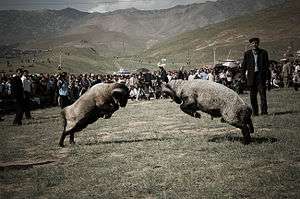Ram fighting

A ram fighting is a blood sport between two rams (large-horned male sheep), held in a ring or open field. It is commonly found in sheep or goat husbandry culture in Africa, Asia and Europe.[1] In Nigeria, Uzbekistan and Indonesia, ram fighting gains popularity among locals.[2] Although categorized as a blood sport and an act of animal cruelty, ram fight rarely resulted in the death of defeated ram, as the loser often allowed to flee the arena.
History
In the wild, a ram fight occurs naturally as a bovine behaviour to settle dominance hierarchy — a contest for alpha male status among virile rams; by ramming their heads into others.[1] Traditionally, the male aggressivity is not a desirable quality among sheep husbandry, as the sheep farmers prefer a docile sheep and eliminate the aggressive ones through series of selective breedings. This is the main practice of sheep domestication over times. However, farmers and shepherds traditionally may took ram fighting as an occasional pastime or entertainment, and look for this behaviour as the sign of virility, health, also good gene and immune system.
In some culture it has been developed into a "game" or a sport, or even held as "national pastime" which sometimes involves betting. Today in some countries, there are efforts to bring the fighting into mainstream by regulating the rules, ensure the fairness and the welfare of the fighting rams.[2] In Uzbekistan, ram fighting is held as part of Asrlar Sadosi.[3] In West Java, Indonesia, ram fighting is held as popular entertainment and ritual.[4] It is associated with the town of Garut, near Bandung.[5] In Nigeria, owners of the participating rams have made large investments to specially train their rams since their youth solely for competitions only, in which there are grand prizes, such as automotive vehicles, for the winners of these fights. [6]
See also
References
- 1 2 Bradford, Alina (31 July 2014). "Rams: Facts About Male Bighorn Sheep". Live Science.
- 1 2 "Ram Fighting Battles For Acceptance in Nigeria". NBC News. 25 March 2016.
- ↑ "Asrlar Sadosi festival celebrates Uzbek traditions". Caravanistan.
- ↑ "Ram Fighting in Indonesia". The Sydney Morning Herald. 26 January 2012.
- ↑ "Ram Fighting in Indonesia". Getty Images.
- ↑ "General Reference Center GOLD - Document - Ram Fighting to Feature At 2016 National Sports Festival". go.galegroup.com. Retrieved 2016-10-22.
External links
| Wikimedia Commons has media related to Fights between sheep. |